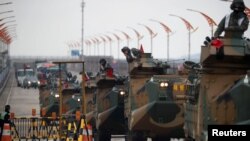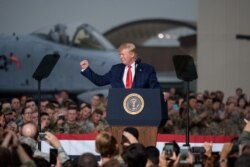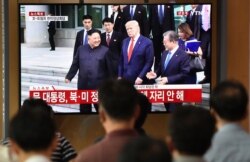The United States’ demand for a significant increase in South Korea’s share of defense costs for keeping U.S. troops stationed in the east Asian nation could potentially backfire on its defense planning by reducing Seoul’s capabilities to purchase American-made weapons, according to a defense expert.
Bruce Bennett, a senior defense analyst at the U.S.-based Rand Corp. research center, said if Seoul agrees to pay a much bigger portion of the burden cost, it would have to come primarily out of South Korea’s Research and Development and Defense Acquisition Program Administration (DAPA) in its Defense Ministry.
This means Seoul’s Defense Ministry would have a reduced budget to purchase military weapons from major U.S. defense contractors, according to Bennett.
“So fundamentally, what the U.S. is asking South Korea to do is to reduce the South Korean purchases of American weapons systems so that companies like Raytheon and Lockheed Martin and Boeing will actually lose purchases that have been planned if there’s a significant increase in the burden-sharing, which means Americans are going to lose jobs,” Bennett said.
“I don’t think that’s what the administration realizes is going to happen,” he continued. “But that’s really the only alternative that’s available in (South) Korea, as far as I understand.”
Cost-sharing talks
U.S. and South Korean negotiators began their defense cost-sharing talks Tuesday, according to the State Department, for keeping about 28,000 U.S. troops stationed in South Korea. The talks for the Special Measures Agreement that are slated to last until Thursday will likely center around how much South Korea will agree to pay.
Before departing for Hawaii, where he was to meet with his American counterpart James DeHart, South Korean negotiator Jeong Eun-bo said Seoul will shoulder a share that is “reasonable and equitable.”
President Donald Trump tweeted in August that “South Korea has agreed to pay substantially more money to the United States in order to defend itself from North Korea.” South Korea paid $924 million this year, an increase from $850 million paid in 2018. This year’s agreement is set to expire in December.
The DAPA ordered 40 F-35A stealth fighters built by Lockheed Martin through the Pentagon’s Foreign Military Sales program in 2014 for $6.8 billion. The delivery of all 40 are expected to be completed by 2021.
At the same time, an increased cost-sharing for South Korea could mean weakened capabilities to defend against a potential North Korean threat, as it would have a reduced budget to buy advanced weapons from the United States, according to Bennett.
“At this point in time with the North Korean nuclear weapons threat, that is really not a good idea,” Bennett said. “Any significant increase (in Seoul’s cost-sharing) hurts American employees of defense contractors and reduces the capabilities planned for the defense of South Korea. Both of those are bad outcomes.”
North Korea tested multiple missiles over the summer, including a submarine-launched ballistic missile and improved multiple rocket launchers, demonstrating it has continued the development of advanced weapons while maintaining diplomacy with the U.S.
US troops essential
David Maxwell, a former U.S. Special Forces colonel, said U.S. troop presence in South Korea is essential for the alliance to defend against a potential provocation by North Korea.
“It is critically important that U.S. troops remain in (South) Korea for both (South Korea) and the U.S., as U.S. troops are key to deterrence” of North Korean threats, said Maxwell, a current fellow at the Foundation for Defense of Democracies.
However, Trump’s order of the U.S. troop withdrawal from Syria earlier this month has struck fear among some South Koreans that Trump’s aversion for alliances and repeated statements expressing it is expensive to keep U.S. troops in South Korea could lead to a possible U.S. pullout from South Korea.
The U.S. withdrew its forces from Syria, leaving the Kurds who fought alongside the U.S. against Islamic State vulnerable to attacks by Turkey, which considers the Kurds terrorists.
“If the U.S. were to withdraw U.S. troops from South Korea, that would effectively be an abandoning of the alliance,” Bennett said. “If the alliance is abandoned, it would probably mean our nuclear umbrella (over the Korean Peninsula) would also go away.”
Bennett said a couple of ripple effects could occur as a result, including South Korea’s decision to develop and deploy nuclear weapons. He added that this could lead to a nuclear arms race in East Asia and the end of the U.S. nuclear nonproliferation policy in the region, because Japan would emulate the South Koreans and China would seek to develop more nuclear weapons than both Japan and South Korea combined.
More importantly, Bennett said, it could make South Korea more vulnerable to threats by North Korea, which has a military supremacy over South Korea.
“With its probably 30 to 60 nuclear weapons, North Korea likely has military superiority over South Korea, especially since South Korea’s (military) manpower is declining rapidly right now,” Bennett said.
The number of South Korean soldiers is likely to drop from 560,000 to 365,000 by 2022, and another 100,000 decrease by 2026, he said.
Bruce Bechtol, a former intelligence officer at the U.S. Defense Intelligence Agency and now a professor at Angelo State University in Texas, said that while North Korea’s short-term goal is obtaining sanctions relief, it wants the United States to withdraw its troops from South Korea to achieve its long-term objective, which is to dominate and control South Korea.
“The long-term goals of North Korea have never changed since the end of the Korean War,” Bechtol said. North Korea’s “long-term goal is the subjugation or domination of the Korean Peninsula. And what’s the best way to get a start on that? By removing American troops from the Korean Peninsula.”
As evidence of its goal, Bechtol pointed out that Pyongyang has not destroyed any of its offensive weapons, although it has been nearly two years since Washington and Pyongyang began their denuclearization talks.
“North Korea has not dismantled one missile,” Bechtol said. “They have not disarmed one military unit, one infantry unit, not one artillery unit. They haven’t moved any of their artillery back from the DMZ (demilitarized zone)” that bisect the two Koreas.”
Maxwell said, “We must remember … the regime’s seven-decades-old strategy. It is a strategy based on subversion, coercion, extortion, and use of force to dominate the Korean Peninsula. … A key supporting line of effort to the strategy is to remove U.S. troops from the Korean Peninsula, or the divide-and-conquer strategy — divide the (South Korean and) U.S. alliance to conquer South Korea.”
North Korea sees the U.S. military presence in South Korea as a threat to its regime and has repeatedly demanded the allies halt their regularly held joint military exercises while testing its missiles over the summer.













